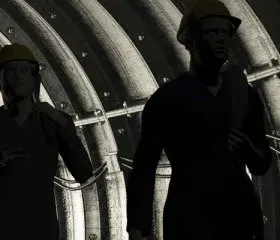/186087533-1600x400.jpg?width=300&name=186087533-1600x400.jpg)
CRITICAL AREAS OF CONFINED SPACE SAFETY
The critical areas to consider are:
All confined spaces that personnel may need to enter must be identified. The identification must be based on the detailed definitions of confined spaces, as per the relevant regulations and Australian Standards.
All confined spaces must be registered in the Confined Spaces Register or Hazard Register.
A review must be conducted of all confined spaces on site to determine whether the need to enter them can be eliminated altogether or alternatively, the frequency may be reduced. Specialists must participate in this review, as required.
Such a review must also be conducted during the design phase of all new facilities that include confined spaces.
The hazards associated with each confined space must be identified and documented. Hazards to be considered prior to entry into a confined space must include, but are not limited to:
- Suffocation
- Poisoning
- Moving parts
- Fire
- Explosion
- Drowning
- Burial under solids
- Electrocution
- Radiation
- Burning and scalding
- Any other hazard, specific to a particular confined space.
A Confined Space Work Permit must be issued for any entry into a confined space or for any work in or on the outside of a confined space. The issue of Permits for Work on the outside surface of a confined space must apply if:
- There is any risk to the persons carrying out the work; or
- If there is a risk of fire or explosion.
Persons authorised to issue these certificates must be trained in confined space hazards.
Before issuing the permit, the issuer must consider whether the work can be carried out without entering the confined space and must ensure that all persons working in or on the confined space have been trained in confined space entry.
The Work Permit must specify preparations for entry, such as:
- Physical isolation including the isolation of hydraulic and pneumatic systems
- Electrical isolation
- Cleaning and purging
- Decontamination
- Testing of the atmosphere
- The use of personal protective equipment
- Briefing of the person(s) carrying out the work and the Standby Person(s).
The process for issuing the permit must include a risk assessment by a competent person or persons before work associated with the confined space is carried out.
The assessment must be in writing and take into account at least the following:
- the nature and inherent hazards of the confined space;
- the work required to be done, including the need to enter the confined space;
- the range of methods by which the work can be done;
- the hazards and associated risks involved with the actual method selected and equipment proposed to be used;
- emergency response procedures; and
- the competence of the persons to undertake the work.
The risk assessment must be revised whenever there is evidence to indicate that it is no longer valid.
The concentration of oxygen in the atmosphere within a confined space and the increase in the level of flammable gases must be in accordance with Australian Standard AS 2865-2001.
The work in the confined space must be carried out as specified in the permit and all the required precautions must be strictly followed.
The stand-by person must follow the instructions for their duties and not leave their position while person(s) are in the confined space. In the event of an injury or collapse of the person in the confined space, the standby person's primary duty is to summon help and, if possible, provide assistance, first-aid, resuscitation, etc. The standby person must not enter the confined space.
Confined spaces demand more than procedures—they require system-level control.
We’ll help you embed confined space safety into a WHS Management System that ensures compliance, consistency, and critical risk management.Download Your Free Checklist PDF
Get instant access to our expert-designed checklist to help you. Simply fill out the form below to download your copy.SIMILAR READINGS

3 min read
3 min read
For the safety of the public and your employees, steps must...

2 min read
2 min read
Keep contractors and consultants safe on your work...
Read More
4 min read
4 min read
Protect your staff with a rigorous and systematic Permit to...
Read More
2 min read
2 min read
What are your obligations in regards to safety when it...
Read More